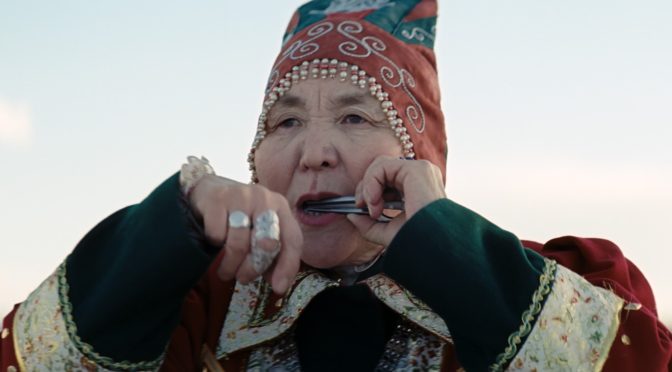 ÁGA is a slow and pensive film by Bulgarian director and writer Milko Lazarov. The film’s small cast is centred on Nanook (Mikhail Aprosimov) and Sedna (Feodosia Ivanova), an elderly Inuit couple struggling to adapt to a rapidly changing world.
ÁGA is a slow and pensive film by Bulgarian director and writer Milko Lazarov. The film’s small cast is centred on Nanook (Mikhail Aprosimov) and Sedna (Feodosia Ivanova), an elderly Inuit couple struggling to adapt to a rapidly changing world.
Although the shadow of climate change is cast over the snow-filled environment, ÁGA, for the most part, feels detached from the ‘real world’ as we know it. We begin with Sedna dressed in traditional costume playing the ‘Jew’s harp’, a fascinating instrument that is held in the mouth and emits the most enchanting and extraterrestrial of sounds. It’s an arresting opening to a film that is visually stunning throughout.
In the film, we see Nanook and his dog make their way through the Arctic tundra in pursuit of water and food. The starkly white landscape set against a blue sky is stunning to behold, seeming almost like an alien planet. Through its minimalist, documentary-style approach, which relies heavily on the natural sounds of its world, ÁGA is evocative to such an extent that you can almost feel the biting wind on your skin.
“ÁGA is evocative to such an extent that you can almost feel the biting wind on your skin.”
ÁGA is a film about opposites and their interactions with one another: male and female, young and old, natural and unnatural. The pure blue sky, for instance, is sometimes distorted by the condensation trails left by aeroplanes high above. Meanwhile, Chena (Sergei Egorov)- Nanook and Sedna’s son – disrupts their traditional ways when he brings a radio into their home, whilst a violent storm threatens to tear apart the yurt.
A central theme of ÁGA is family. Although Chena still regularly visits them, Nanook and Sedna have lost contact with their daughter Ága (Galina Tikhonova). Curiously, despite being the character after whom the film is named, Ága plays only a small role, although it is evident that her lack of presence is a heavy weight on her parents’ minds. The cause of the familial rift is never explained, but the sorrow of Nanook and Sedna at their daughter’s estrangement is conveyed in an understated and moving manner.
For this reason, the inclusion of stirring string music in later segments of the film feels unnecessary, as we don’t need music to understand what the characters are going through. In ÁGA, the music of nature – whether that be the crackling of fire or the rhythmic chopping of wood – is far more effective than generic orchestral music. The inclusion of more traditional Inuit music, like at the beginning, would have been better suited to the context.
“The cause of the familial rift is never explained, but the sorrow of Nanook and Sedna at their daughter’s estrangement is conveyed in an understated and moving manner.”
ÁGA excels in conveying the minute details of ordinary Inuit life, as well as the simple grandeur of the setting: We see two ravens, for instance, fighting poetically in the sky. Lazarov loves to linger with the camera so that even a mundane bowl, for example, is briefly transformed into a prop in a still life painting. Occasionally the focus lingers a little too long, suggesting perhaps that ÁGA is more a short film that has been stretched out to the 96 minutes of a feature film.
The subplot about Ága’s estrangement from her parents is less interesting than the relationship of Nanook and Sedna themselves. Though not a romance in the traditional sense, ÁGA depicts the familiar love that exists between these two people. Sometimes their dialogue takes on a magical realist slant, as Sedna describes her dream about a boy who turns into a polar bear. Although jarring a little with the film’s otherwise bluntly realist atmosphere, these dream narratives further anchor ÁGA in the culture and traditions of the Inuit.
ÁGA was screened as part of Luminate, Scotland’s creative ageing festival.


What is the back ground Western orchestral music in “Aga”?
Mahler’s 5th, for some part where nanook says that the composer ‘must have suffered’.